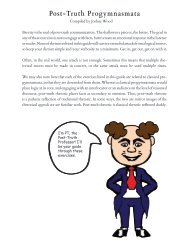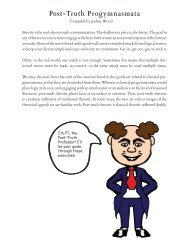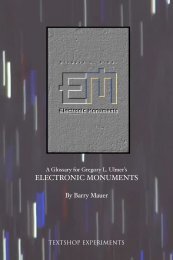Sound in/as :: Memory and Place
Sound in/as :: Memory and Place Symposium on Sound, Rhetoric, and Writing Larissa Babak & Benjamin Lauren Textshop Experiments 6 (2019) TextshopExperiments.org
Sound in/as :: Memory and Place
Symposium on Sound, Rhetoric, and Writing
Larissa Babak & Benjamin Lauren
Textshop Experiments 6 (2019)
TextshopExperiments.org
You also want an ePaper? Increase the reach of your titles
YUMPU automatically turns print PDFs into web optimized ePapers that Google loves.
Introduction<br />
When we orig<strong>in</strong>ally discussed develop<strong>in</strong>g the exhibits detailed<br />
<strong>in</strong> this booklet, our idea w<strong>as</strong> to th<strong>in</strong>k through the development<br />
of the work from a user experience st<strong>and</strong>po<strong>in</strong>t. Above all, we<br />
wanted to emph<strong>as</strong>ize empathy for the people who would ultimately<br />
use the exhibits. For us, empathy meant clarity of purpose<br />
<strong>and</strong> design that w<strong>as</strong> <strong>in</strong>tuitive <strong>and</strong> responsive not just to<br />
user needs, but to their ability to participate. As a context for<br />
this work, we had spent some time discuss<strong>in</strong>g N<strong>in</strong>a Simon’s<br />
work on participation <strong>in</strong> museums, specifically the importance<br />
of participation <strong>in</strong> learn<strong>in</strong>g <strong>and</strong> express<strong>in</strong>g emotions not e<strong>as</strong>ily<br />
categorized or catalogued. We felt <strong>in</strong>spired by the potential<br />
for sound to provide an outlet for people to express themselves,<br />
<strong>and</strong> we believed that our exhibits had to foreground<br />
participation not only <strong>as</strong> a concept, but <strong>as</strong> a design feature.<br />
What we found throughout the development process w<strong>as</strong><br />
that we faced a great deal of ethical <strong>and</strong> rhetorical decisions.<br />
Some of the ethical decision-mak<strong>in</strong>g w<strong>as</strong> conceptually tied<br />
to the transformational processes offered by critical mak<strong>in</strong>g<br />
practices. While we discuss critical mak<strong>in</strong>g a bit more <strong>in</strong><br />
depth <strong>in</strong> the next section of this booklet, we mention it here<br />
<strong>as</strong> an essential touchpo<strong>in</strong>t of our work. For us, critical mak<strong>in</strong>g<br />
<strong>in</strong>vited us to transform tools to move ide<strong>as</strong> or emotional response<br />
<strong>in</strong>to a more or less lim<strong>in</strong>al space that could be iterated<br />
through trial <strong>and</strong> error--a sense of guided “play.” Our play w<strong>as</strong><br />
guided by what the audience might do with the exhibit. In<br />
this way, our ethical imperative w<strong>as</strong> to make space for people<br />
to participate--to arrive at their own conclusions <strong>and</strong> achieve<br />
their own goals or epiphanies without us overtly try<strong>in</strong>g to<br />
script their experience. We provided constra<strong>in</strong>ts, yes, but at<br />
the risk of sound<strong>in</strong>g contradictory, we also did not provide any<br />
s<strong>in</strong>gle one course of action. There were many paths through














